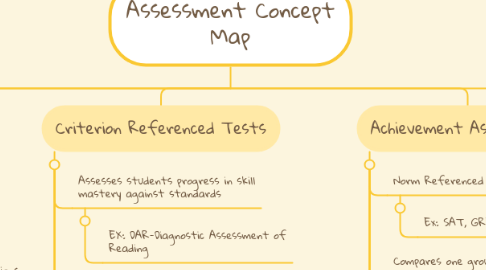
1. Educator's Role:
1.1. Exercise Fairness and Accuracy
1.2. Include enough items to determine mastery of content
1.3. Carefully determine the mastery criterion
1.4. May develop their own assessment
1.5. Use quantitative measurement
2. Special Educator's Role:
2.1. Adhere to legal mandates
2.2. Adhere to Basic Principles of Measurement
2.3. Accountable for Assessment Decisions
2.4. Have knowledge of Various types of assessment
2.5. Have knowledge of when do use each type of assessment
2.6. Consider students with disabilities
3. Criterion Referenced Tests
3.1. Assesses students progress in skill mastery against standards
3.1.1. EX: DAR-Diagnostic Assessment of Reading
3.2. Compares student performance to criterion
3.3. Benefits:
3.3.1. One kit to diagnosis reading at all levels
3.3.2. Identify areas of difficulty
3.3.3. Assesses 5 components in Reading
3.4. History:
3.4.1. Glaser 1963
3.4.1.1. Calls for better measurement techniques
3.4.1.2. Assessment should measure continuum of acquisition or mastery
3.4.2. Millman 1994
3.4.2.1. called for item density
3.4.3. Hart & Scuitto 1996
3.4.3.1. Criterion assessments practical
3.4.3.2. Possess social validity
3.4.3.3. Assist with educational accountability
4. Achievement Assessments
4.1. Norm Referenced Tests
4.1.1. Ex: SAT, GRE, WISC/IQ Tests
4.2. Compares one group or individual to peers
4.3. Measures academic performance
4.4. Most Frequently used in Education
4.5. History:
4.5.1. Early Decades of the 20th Century
4.5.1.1. Introduction of the IQ Test
4.5.1.1.1. permitted educators to blame poor attainment on ability of child or home atmosphere
4.5.1.1.2. used as a selection device to place students by ability
4.5.1.2. Introduction of Multiple Choice Format 1914
4.5.1.2.1. Increased test volume
4.5.1.3. Spurred growth
5. Standardized Diagnostic Assessments
5.1. More in-depth/comprehensive
5.2. EX: Key Math, TOMA-2, WRMT-R, TOWL-2, TWS-3
5.3. Administered by School Psychologist
5.3.1. trained to have a deep understanding and note behaviors
5.4. One topic only-part of total assessment
5.5. Individual: Strengths and Deficits
5.6. Used after RTI, consideration of disability, re-evaluation, data collection, and to make recommendations
5.7. History:
5.7.1. ESSA replaces NCLB 2015
5.7.1.1. Allowed state and district flexibility
5.7.1.2. Allowed states to administer multiple tests for a final score
5.7.1.3. Recommend states test students in their commonly spoken language
5.7.1.4. Allowed options for students with severe cognitive disabilities (1%)
5.7.1.5. Allowed states to use SAT and ACT as testing options
5.7.1.5.1. Forced SWD to choose testing without accommodations or submission to college
